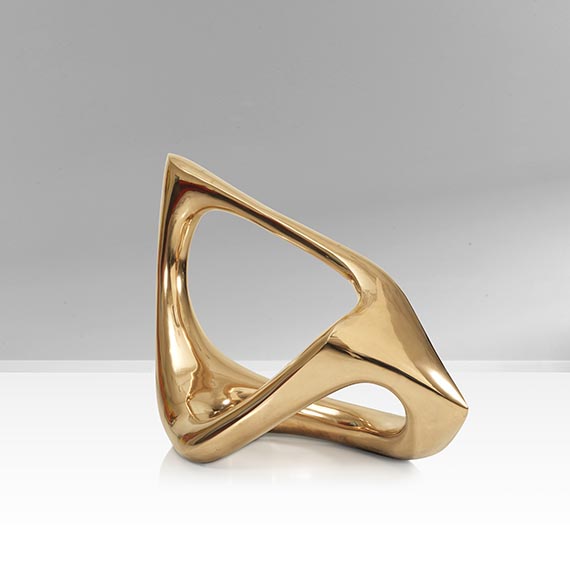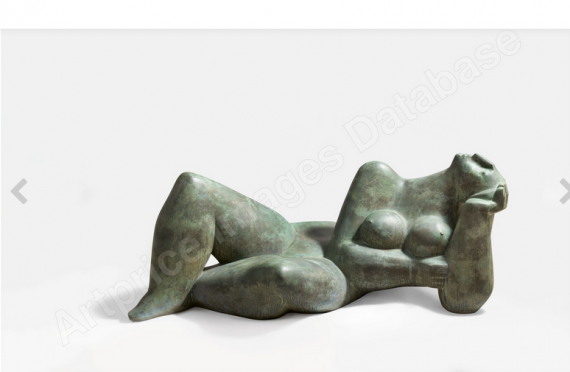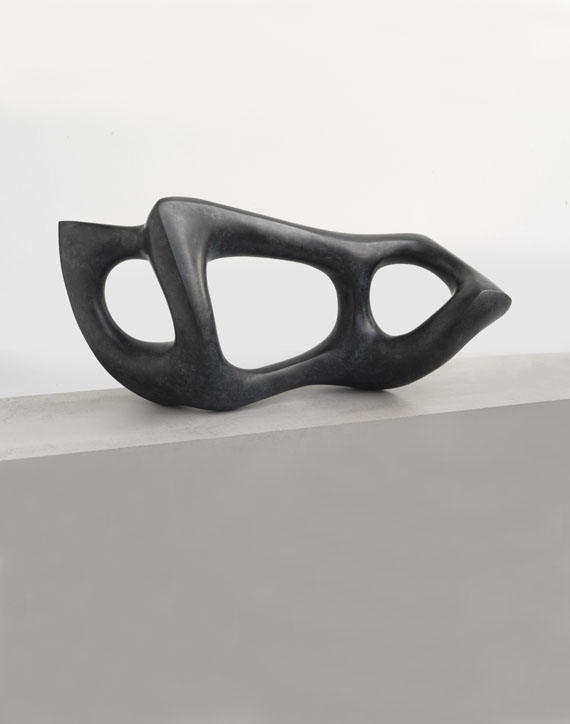Verso
Autre image
Autre image
Autre image
Autre image
64
Karl Hartung
Umschlossener Raum, 1953.
Bronze, polished
Estimation: € 100,000 / $ 107,000
Umschlossener Raum. 1953.
Bronze, polished.
From an edition of 6+1 copies. Ca. 124 x 164 x 83 cm (48.8 x 64.5 x 32.6 in).
• One of the artist's rare, large-scale works.
• An expressive symbiosis of clear, abstract formal language and a particularly sensual materiality.
• The work has a unique spatial presence and offers appealing perspectives from every angle.
• Another copy of this bronze is at the Schleswig-Holstein State Museum at Gottorf Palace in Schleswig.
• This is the first time that a copy of this grand sculpture is offered on the international auction market (source: artprice.com).
We are grateful to the Karl Hartung Estate for the kind expert advice.
PROVENANCE: From the artist's estate.
EXHIBITION: Bildhauer und Maler am Steinplatz, Staatliche Kunsthalle, Berlin, October 29 - November 23, 1986 (different copy).
Karl Hartung 1908-1967. Eine Werkübersicht zum 80. Geburtstag, Galerie Pels-Leusden, Berlin, September 3 - October 29, 1988, p. 70, cat. no. 52 (different copy).
Karl Hartung. Skulpturen und Zeichnungen, Galerie Utermann, Dortmund 1989 (different copy).
Blickachsen 4, Bad Homburg, May 18 - October 5, 2003 (different copy).
50 Jahre gesammelt für Schloss Gottorf 1970-2020 (50 Jahre Kulturring), Schleswig-Holsteinische Landesmuseen, Schloss Gottorf, Schleswig, March 31 - October 3, 2022, p. 152 (illu., different copy).
Reine Formsache. Hommage an Karl Hartung, July 16 - December 17, 2023, Herbert Gerisch Foundation, Neumünster.
LITERATURE: Markus Krause, Karl Hartung 1908-1967: Metamorphosen von Mensch und Natur (monograph and catalogue raisonné), Munich 1998, p. 237, no. 502 (illu.).
Called up: June 7, 2024 - ca. 19.06 h +/- 20 min.
Bronze, polished.
From an edition of 6+1 copies. Ca. 124 x 164 x 83 cm (48.8 x 64.5 x 32.6 in).
• One of the artist's rare, large-scale works.
• An expressive symbiosis of clear, abstract formal language and a particularly sensual materiality.
• The work has a unique spatial presence and offers appealing perspectives from every angle.
• Another copy of this bronze is at the Schleswig-Holstein State Museum at Gottorf Palace in Schleswig.
• This is the first time that a copy of this grand sculpture is offered on the international auction market (source: artprice.com).
We are grateful to the Karl Hartung Estate for the kind expert advice.
PROVENANCE: From the artist's estate.
EXHIBITION: Bildhauer und Maler am Steinplatz, Staatliche Kunsthalle, Berlin, October 29 - November 23, 1986 (different copy).
Karl Hartung 1908-1967. Eine Werkübersicht zum 80. Geburtstag, Galerie Pels-Leusden, Berlin, September 3 - October 29, 1988, p. 70, cat. no. 52 (different copy).
Karl Hartung. Skulpturen und Zeichnungen, Galerie Utermann, Dortmund 1989 (different copy).
Blickachsen 4, Bad Homburg, May 18 - October 5, 2003 (different copy).
50 Jahre gesammelt für Schloss Gottorf 1970-2020 (50 Jahre Kulturring), Schleswig-Holsteinische Landesmuseen, Schloss Gottorf, Schleswig, March 31 - October 3, 2022, p. 152 (illu., different copy).
Reine Formsache. Hommage an Karl Hartung, July 16 - December 17, 2023, Herbert Gerisch Foundation, Neumünster.
LITERATURE: Markus Krause, Karl Hartung 1908-1967: Metamorphosen von Mensch und Natur (monograph and catalogue raisonné), Munich 1998, p. 237, no. 502 (illu.).
Called up: June 7, 2024 - ca. 19.06 h +/- 20 min.
Starting in the 1930s, Hartung's art transformed a renunciation of naturalistic and realistic German sculpture. Hartung created entirely abstract works and also made his figurative works subject to increased abstraction. Although the human, primarily female figure, its forms, and physiognomy, remained an important theme, the radical reduction and high degree of abstraction of some of his works was unusual at the time. His “Vegetative”, “Free” and “Organic Forms”, from around the late 1940s/early 1950s, are characterized by transgressing the boundaries of abstraction, finding a completely new and free formal language, and exploring the idea of a sculptural structure with openings. This development culminated in “Umschlossener Raum" (Enclosed Space) in 1953.
The work does not imitate nature, nor does it hint at human physiognomy. Instead, Hartung created a particularly graceful and dynamic composition with a tense asymmetry, straight lines, gentle curves, and tapered ends. Three linear elements run from one tip to the other in sloping, both ascending and descending dynamic diagonals, leaving large openings that allow the viewer to perceive the surrounding space that is reflected in the highly polished surface. In doing so, Hartung created both an interior and exterior space: a space within the linear framework that is linked to the exterior space through openings and reflections, forming a harmonious and simultaneously appealing symbiosis. Instead of voluminous plasticity, Hartung created an elegant composition with a strong presence and a sensual material quality that reflects the light and changes with the viewer's angle. It is an autonomous structure and a universally valid, abstract form of timeless beauty that is unique within Hartung's oeuvre.
Shortly after the end of the war, Karl Hartung finally achieved his artistic breakthrough. His first solo exhibitions took place at the Galerie Gerd Rosen (both in 1946 and 1948) and at the Galerie Springer in Berlin. In 1949, Hartung participated in the first major exhibition of the international artists' association "CoBrA", founded in 1948, at the Stedelijk Museum in Amsterdam. In 1952, the Haus am Waldsee, Berlin, presented a comprehensive exhibition of his work, followed by further large-scale solo exhibitions the year our work was made, among others at the Museum Folkwang, Essen, the Kestner-Gesellschaft, Hanover, the Osthaus Museum, Hagen, and the Bremer Kunsthalle (1953/54).
With a singular position within abstract sculpture developed around 1950, Karl Hartung became established as a significant sculptor in the second half of the 20th century alongside contemporary luminaries like Hans Arp, Barbara Hepworth, and Henry Moore. [CH]
The work does not imitate nature, nor does it hint at human physiognomy. Instead, Hartung created a particularly graceful and dynamic composition with a tense asymmetry, straight lines, gentle curves, and tapered ends. Three linear elements run from one tip to the other in sloping, both ascending and descending dynamic diagonals, leaving large openings that allow the viewer to perceive the surrounding space that is reflected in the highly polished surface. In doing so, Hartung created both an interior and exterior space: a space within the linear framework that is linked to the exterior space through openings and reflections, forming a harmonious and simultaneously appealing symbiosis. Instead of voluminous plasticity, Hartung created an elegant composition with a strong presence and a sensual material quality that reflects the light and changes with the viewer's angle. It is an autonomous structure and a universally valid, abstract form of timeless beauty that is unique within Hartung's oeuvre.
Shortly after the end of the war, Karl Hartung finally achieved his artistic breakthrough. His first solo exhibitions took place at the Galerie Gerd Rosen (both in 1946 and 1948) and at the Galerie Springer in Berlin. In 1949, Hartung participated in the first major exhibition of the international artists' association "CoBrA", founded in 1948, at the Stedelijk Museum in Amsterdam. In 1952, the Haus am Waldsee, Berlin, presented a comprehensive exhibition of his work, followed by further large-scale solo exhibitions the year our work was made, among others at the Museum Folkwang, Essen, the Kestner-Gesellschaft, Hanover, the Osthaus Museum, Hagen, and the Bremer Kunsthalle (1953/54).
With a singular position within abstract sculpture developed around 1950, Karl Hartung became established as a significant sculptor in the second half of the 20th century alongside contemporary luminaries like Hans Arp, Barbara Hepworth, and Henry Moore. [CH]
64
Karl Hartung
Umschlossener Raum, 1953.
Bronze, polished
Estimation: € 100,000 / $ 107,000
Commission, taxes et droit de suite
Cet objet est offert avec imposition régulière.
Calcul en cas d'imposition régulière:
Prix d’adjudication jusqu’à 800 000 euros : frais de vente 27%.
Des frais de vente de 21% sont facturés sur la partie du prix d’adjudication dépassant 800 000 euros. Ils sont additionnés aux frais de vente dus pour la partie du prix d’adjudication allant jusqu’à 800 000 euros.
Des frais de vente de 15 % sont facturés sur la partie du prix d’adjudication dépassant 4 000 000 euros. Ils sont additionnés aux frais de vente dus pour la partie du prix d’adjudication allant jusqu’à 4 000 000 euros.
La taxe sur la valeur ajoutée allemande, actuellement de 19 %, est perçue sur la somme du prix d’adjudication et des frais de vente. Exception : la taxe sur la valeur ajoutée réduite de 7 % est appliquée pour les livres imprimés.
Pour les entreprises habilitées à déduire la TVA, le régime fiscal général peut être appliqué.
Calcul en cas de droit de suite:
Pour les œuvres originales d’arts plastiques et de photographie d’artistes vivants ou d’artistes décédés il y a moins de 70 ans, soumises au droit de suite, une rémunération au titre du droit de suite à hauteur des pourcentages indiqués au § 26, al. 2 de la loi allemande sur les droits d’auteur (UrhG) est facturée en sus pour compenser la rémunération liée au droit de suite due par le commissaire-priseur conformément au § 26 UrhG. À ce jour, elle est calculée comme suit :
4 pour cent pour la part du produit de la vente à partir de 400,00 euros et jusqu’à 50 000 euros,
3 pour cent supplémentaires pour la part du produit de la vente entre 50 000,01 et 200 000 euros,
1 pour cent supplémentaire pour la part entre 200 000,01 et 350 000 euros,
0,5 pour cent supplémentaire pour la part entre 350 000,01 et 500 000 euros et
0,25 pour cent supplémentaire pour la part au-delà de 500 000 euros.
Le total de la rémunération au titre du droit de suite pour une revente s’élève au maximum à 12 500 euros.
Calcul en cas d'imposition régulière:
Prix d’adjudication jusqu’à 800 000 euros : frais de vente 27%.
Des frais de vente de 21% sont facturés sur la partie du prix d’adjudication dépassant 800 000 euros. Ils sont additionnés aux frais de vente dus pour la partie du prix d’adjudication allant jusqu’à 800 000 euros.
Des frais de vente de 15 % sont facturés sur la partie du prix d’adjudication dépassant 4 000 000 euros. Ils sont additionnés aux frais de vente dus pour la partie du prix d’adjudication allant jusqu’à 4 000 000 euros.
La taxe sur la valeur ajoutée allemande, actuellement de 19 %, est perçue sur la somme du prix d’adjudication et des frais de vente. Exception : la taxe sur la valeur ajoutée réduite de 7 % est appliquée pour les livres imprimés.
Pour les entreprises habilitées à déduire la TVA, le régime fiscal général peut être appliqué.
Calcul en cas de droit de suite:
Pour les œuvres originales d’arts plastiques et de photographie d’artistes vivants ou d’artistes décédés il y a moins de 70 ans, soumises au droit de suite, une rémunération au titre du droit de suite à hauteur des pourcentages indiqués au § 26, al. 2 de la loi allemande sur les droits d’auteur (UrhG) est facturée en sus pour compenser la rémunération liée au droit de suite due par le commissaire-priseur conformément au § 26 UrhG. À ce jour, elle est calculée comme suit :
4 pour cent pour la part du produit de la vente à partir de 400,00 euros et jusqu’à 50 000 euros,
3 pour cent supplémentaires pour la part du produit de la vente entre 50 000,01 et 200 000 euros,
1 pour cent supplémentaire pour la part entre 200 000,01 et 350 000 euros,
0,5 pour cent supplémentaire pour la part entre 350 000,01 et 500 000 euros et
0,25 pour cent supplémentaire pour la part au-delà de 500 000 euros.
Le total de la rémunération au titre du droit de suite pour une revente s’élève au maximum à 12 500 euros.




 Lot 64
Lot 64 

